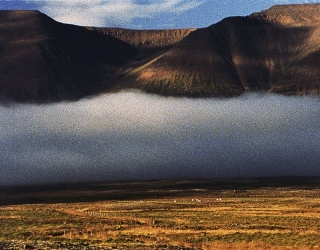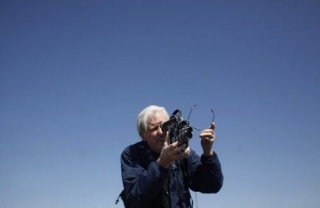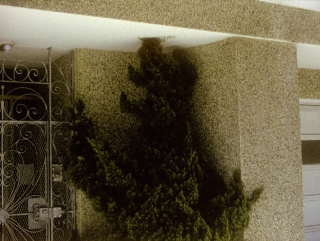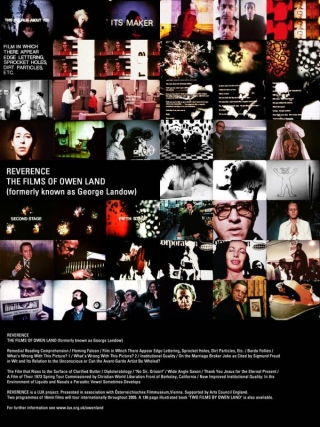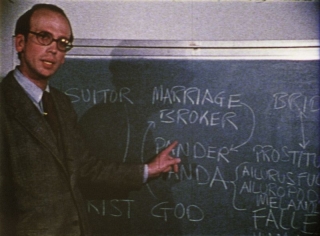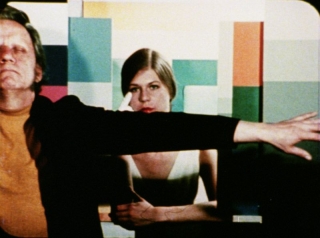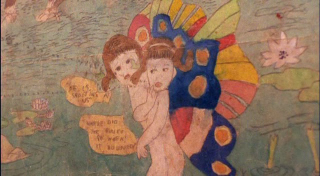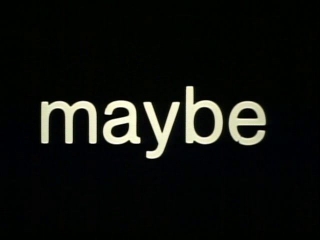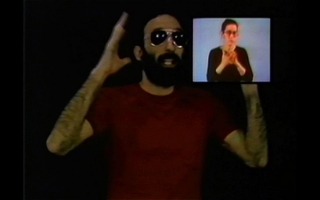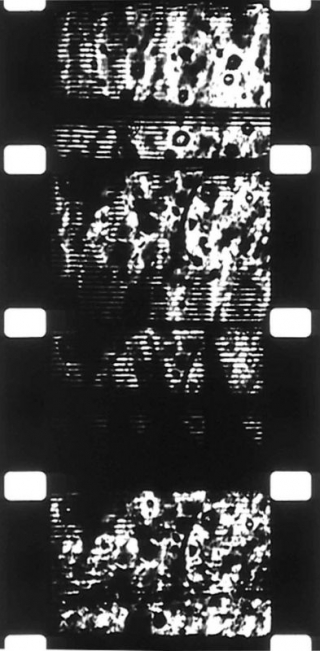Date: 31 October 2004 | Season: London Film Festival 2004 | Tags: London Film Festival
DRIFT STUDIES
Sunday 31 October 2004, at 9pm
London National Film Theatre NFT3
Nicky Hamlyn, Water, Water, UK, 2004, 11 min
Reflections and refractions of light, alternated in hard, optical flicker and gliding dissolves.
Emily Richardson, Aspect, UK, 2004, 9 min
A time-lapse chronicle of the modulation of natural light, from high above the canopy of trees to the filtered rays on the forest floor.
Peter Hutton, Skagasfjördur, USA, 2004, 35 min
Photographic study of the mists, clouds and extraordinary landscapes of the mysterious land of the sagas. Peter Hutton has fixed his camera on the awesome panoramas of Iceland and created a monumental film, which records the subtle luminosity of the region and its dramatic atmospheric conditions.
Yuiko Matsuyama, Flower, Japan, 2004, 6 min
The meandering flow of china ink, suspended in water, opens up a microcosmic world of Brownian motion.
Bart Vegter, Zwerk, Netherlands, 2004, 8 min
An abstract, computer-generated work produced by using mathematical formulae to create complex interference patterns in colour tinted layers.
Jürgen Reble, Arktis – Zwischen Licht und Dunkel, Germany, 2003, 32 min
This new video is a surprising departure for Reble, who is best known for his alchemical treatment of celluloid. Digitally processed, it transforms shots of the arctic landscape, drawn from education films and travelogues, into a virtual fantasy world illuminated by the hallucinatory half-light of evening.
PROGRAMME NOTES
DRIFT STUDIES
Sunday 31 October 2004, at 9pm
London National Film Theatre NFT3
WATER, WATER
Nicky Hamlyn, UK, 2004, 16mm, b/w & colour, silent, 11 min
Water Water revisits the bathroom location of a previous film White Light (1996). It is based around a set of antinomies that operate at various levels, from between frames to between the two halves of the film. The black and white first part is composed of individually filmed frames (animation) which form shots of interlaced contrary motion that nevertheless can be read as sequences of individual frames, and/or in which alternate frames are lit in contrasting ways so as to emulate negative-positive juxtapositions. In the colour second half, dissolves replace cuts, light softens and contrast decreases. Continuity, by way of isomorphic features in the room, replaces the discontinuities of part one. (Nicky Hamlyn)
ASPECT
Emily Richardson, UK, 2004, 16mm, colour, sound, 9 min
Aspect was filmed in a forest over the period of a year. Using photographic techniques such as time-lapse and long exposures on single film frames the forest year is condensed into a few minutes. Light, colour and shadow travel across its surface and the film shifts between seeing the trees as trees and seeing the movement of light and shadow abstracting the real environment. Your eye is taken all over the screen with this perpetual movement and change of light and colour. There is no single focal point – it is continuously changing. As with Redshift and Nocturne, light becomes the main protagonist. In Aspect fragments of unconscious forest sounds, ants in their anthill, the wind across the forest floor, the crack of a twig are reconfigured into an audio piece which articulates the film (and the forest) in an illusive and ambiguous way. Sound by Benedict Drew. (Emily Richardson)
SKAGAFJÖRDUR
Peter Hutton, USA, 2004, 16mm, colour, silent, 35 min
Peter Hutton’s films defy easy categorisation, eschewing narrative as well as the abstract formal vocabulary explored in much experimental filmmaking. Rather, his work is related to traditions of the 19th-century landscape painting and still photography. The films are silent and unfold in a series of tableaux separated by black leader, individual shots that are often completely still. The meticulously framed compositions of city views or landscapes are depicted in extended takes, inviting the spectator to take time to look closely. While sharing some formal characteristics of structural film, Hutton’s approach to the medium is more meditative. He states: “The experience of my films is a little like daydreaming. It’s about taking the time to just sit down and look at things, which I don’t think is a very Western preoccupation. A lot of influences on me when I was younger were more Eastern. They suggested a contemplative way of looking … where the more time you spend actually looking at things, the more they reveal themselves in ways you don’t expect.” Skagafjördur draws its title from a particularly striking region of northern Iceland. The film documents the area’s ravishing landscape in a series of serene vistas of rolling hills and open sky. After an introductory sequence in black and white, the film switches to luminous colour to capture the atmospheric play of light on the coastal valley. Hutton finds the mythic character of Iceland in its ancient physical landmarks, like the imposing Drangey Island, as well as in the brilliant, ephemeral moments slowly transforming the landscape. (Henriette Huldisch, Whitney Museum of American Art)
FLOWER
Yuiko Matsuyama, Japan, 2004, 16mm, colour, sound, 6 min
When you look the world of the same size as a pin through the lens of a camera, you see the spectacle of the light shaking greatly and the beautiful dynamic flow spread before the eye. By shooting this beautiful experience repeatedly, a layer of time and space was born. This work using the flow of China Ink is the fourth work of the series begun with Field in 2000. (Yuiko Matsuyama)
ZWERK
Bart Vegter, Netherlands, 2004, 35mm, colour, silent, 8 min
Zwerk is an abstract film that depicts an illusionary world. The film is made with the purpose to create an opportunity to view something as it is. What remains is a visual experience. When making the film I let myself inspire by the words “at the edge of emptiness” and by my interest in the field between chaos and order. Self-written software, light-frequencies and mesmerising abstractions. Silent images which shift between stagnation and continuous movement. (Bart Vegter)
ARKTIS – ZWISCHEN LICHT UND DUNKEL
Jürgen Reble, Germany, 2003, video, colour, sound, 32 min
This new video is a surprising departure for Reble, who is best known for his alchemical treatment of celluloid. Digitally processed, it transforms shots of the arctic landscape, drawn from education films and travelogues, into a virtual fantasy world illuminated by the hallucinatory half-light of evening.
Back to top
Date: 8 November 2004 | Season: LUX Salon
LUX SALON: JEROME HILER
Monday 8 November 2004, at 7:30pm
London LUX
Film artist Jerome Hiler presents a rare 16mm work-in-progress screening of In the Stone House, a project he has been working on since the 1960s.
“The film I am presenting is composed mainly from spontaneous renderings of ordinary life. My method was to work directly with the Bolex camera as a sort of transformation device rather than to dream up some sort of plan and execute that. The moments of vision in the film, be they insightful or mundane, are joined by moments of complete blackout. These blackouts, which are like the blinking of an inner eye, create discontinuity and flow at the same time.
My experience as an artist has shown me that the work produced has been like a mirror held up to myself rather than to nature. My memory of the day before yesterday is already spotty and I have no idea what the next hour will bring. I actually can see myself bumbling from event to event in my life thanks to the very effort I make to establish sense and order in my film. The film, then, is a reflection of that fabulous combination of brilliance in the moment and desperate hoping for the best as it steps forward into unknown territory.”
Jerome Hiler
Date: 9 November 2004 | Season: Nathaniel Dorsky | Tags: London Film Festival, Nathaniel Dorsky
NATHANIEL DORSKY
Tuesday 9 November 2004, at 6:30pm
London Tate Modern
Nathaniel Dorsky is a poetic filmmaker whose delicate works meditate on the intangible wonder of everyday life. His astute cinematography in Arbor Vitae and The Visitation recognises subtle moments of beauty that might otherwise go unnoticed. The films are woven together in a crisp montage, creating synaptic connections between shots and opening up a space for quiet reflection. Alaya, a film that Stan Brakhage declared was “little short of a miracle”, is a more abstract work that uncovers worlds within the movement of grains of sand.
Dorsky, who has been a filmmaker since 1964, makes his first appearances in London this Autumn. His reflections on the spiritual qualities of film were recently published in the book Devotional Cinema (Tuumba Press).
The Visitation, 2002, colour, silent, 18 mins
Alaya, 1976-87, colour, silent, 28 mins
Arbor Vitae, 1999-2000, colour, silent, 28 mins
Nathaniel Dorsky was born in New York, 1943, and has been making and exhibiting films within the avant-garde tradition since 1964. He now lives in San Francisco, where he makes a living as a film editor. His personal films have been shown internationally in museums, festivals and cinematheques and are in the permanent collections of the Museum of Modern Art (New York), Pacific Film Archives (Berkeley), Image Forum (Tokyo) and Centre Georges Pompidou (Paris). Amongst his most celebrated works are Hours for Jerome (1966-82), Pneuma (1976-83), Alaya (1976-87), Variations (1992-98), Arbor Vitae (2000) Love’s Refrain (2001) and The Visitation (2002). A shot of a plastic bag floating in a city street from his film Variations is widely acknowledged as the inspiration for the ‘most beautiful image in the world’ sequence of the Oscar winning feature film American Beauty (2000). Devotional Cinema, Dorsky’s discussion of themes and ideas concerning the spiritual qualities of film was published in 2003 by Tuumba Press. His new film Threnody (2004) will be the centrepiece of his lecture screening at The Times bfi 48th London Film Festival at the National Film Theatre on 31 October 2004.
PROGRAMME NOTES
THE VISITATION
2002, 16mm, colour, silent, 18fps, 18 mins
Part one of a set of Two Devotional Songs. The Visitation is a gradual unfolding, an arrival so to speak. I felt the necessity to describe an occurrence, not one specifically of time and place, but one of revelation in one’s own psyche. The place of articulation is not so much in the realm of images as information, but in the response of the heart to the poignancy of the cuts.
ALAYA
1976-87, 16mm, colour, silent, 18fps, 20 mins
“Alaya manages a perfection of ‘musical’ light across a space of time greater in length than would seem possible…and with minimal means of line and tone … After about three minutes I began to be aware of the subtlety of rhythm, within each shot and shot-to-shot, which carried each cut, causing each new image to sit in-the-light of these several previous. … A little short of a miracle.” (Stan Brakhage)
LOVE’S REFRAIN
2000-01, 16mm, colour, silent, 18fps. 22.5 mins
Perhaps the most delicately tactile in this series, Love’s Refrain rests moment to moment on its own surface. It is a coda in twilight, a soft-spoken conclusion to a set of four cinematic songs.
Back to top
Date: 25 January 2005 | Season: Owen Land | Tags: George Landow, Reverence
REVERENCE: THE FILMS OF OWEN LAND (FORMERLY KNOWN AS GEORGE LANDOW)
January 2005—April 2007
International Touring Programme
“My approach is to throw in everything but the kitch in sync.” (Owen Land, 1997)
Owen Land (formerly known as George Landow) was one of the most original American filmmakers of the 1960s and 1970s. His works fused an intellectual sense of reason with the irreverent wit that distances them from the supposedly ‘boring’ world of avant-garde film.
His early materialist works anticipated Structural Film, the definition of which provoked his rejection of film theory and convention. Having explored the physical qualities of the celluloid strip, his attention turned to the spectator in a series of ‘literal’ films that question the illusionary nature of cinema through the use of elaborate wordplay and visual ambiguity. The characters in Land’s films are often the antithesis of those we might expect to see, such as podgy middle aged men and radical Christians. He sometimes parodies experimental film itself, by mimicking his contemporaries and mocking the solemn approach of its scholars.
Land constructs ‘facades’ of reality, often directly addressing the viewer using the language of television, advertising or educational films, and proposes an alternative logic for a medium that has become over theorised and manipulated. He has exposed the material of film and deconstructed the process and the effect, while covering the ‘big topics’ of religion, psychoanalysis, commerce and pandas making avant-garde movies.
“My films are not intended as entertainment or easy viewing. They do not attempt to engage the spectator on an emotional level. Therefore audience reactions are unpredictable, especially during Diploteratology or Bardo Follies. A showing for the wrong type of audience could be commercially disastrous, though not necessarily without benefit.” (George Landow, 1969)
Programme One
Owen Land, Remedial Reading Comprehension, 1970, 5 min
Owen Land, Fleming Faloon, 1963, 5 min
Owen Land, Film in Which There Appear Edge Lettering, Sprocket Holes, Dirt Particles, Etc., 1965-66, 4 min
Owen Land, Bardo Follies, 1967-76, 25 min
Owen Land, What’s Wrong With This Picture 1, 1971, 5 min
Owen Land, What’s Wrong With This Picture 2, 1972, 7 min
Owen Land, Institutional Quality, 1969, 5 min
Owen Land, On the Marriage Broker Joke as Cited by Sigmund Freud in Wit and its Relation to the Unconscious or Can the Avant-Garde Artist Be Wholed ?, 1977-79, 18 min
Programme Two
Owen Land, The Film that Rises to the Surface of Clarified Butter, 1968, 9 min
Owen Land, Diploteratology, 1967-78, 7 min
Owen Land, “No Sir, Orison!”, 1975, 3 min
Owen Land, Wide Angle Saxon, 1975, 22 min
Owen Land, Thank You Jesus for the Eternal Present, 1973, 6 min
Owen Land, A Film of Their 1973 Spring Tour Commissioned by Christian World Liberation Front of Berkeley, California, 1974, 12 min
Owen Land, New Improved Institutional Quality: In the Environment of Liquids and Nasals a Parasitic Vowel Sometimes Develops, 1976, 10 min
Tour Dates
25/26 January 2005, Austrian Film Museum
28 January-6 February 2005, Rotterdam Film Festival
11/12 & 18/19 February 2005, London Tate Modern
25-26 February 2005, Leeds Lumen
7 March 2005, Newcastle Side Cinema
10/13 March 2005, Barcelona CCCB
17/24 March 2005, Glasgow Film Theatre
30/31 March 2005, Athens Microcosmos
6/8 April 2005, Paris Centre Pompidou
20-24 April 2005, Osnabruck European Media Art Festival
26 April 2005, Bremen Kino 46
1/8 May 2005, Sheffield Showroom
3/4 May 2005, Geneva Cinéma Spoutnik & Esba
22-29 May 2005, Zurich Videoex
23/24 May 2005, Norwich Outpost
9/16 June 2005,Strasbourg Musee d’Art Moderne et Contemporain
15-20 June 2005, Oslo Norwegian Short Film Festival, Oslo
1/5 July 2005, Frankfurt Deutsches Filmmuseum
16 July 2005, Hull International Short Film Festival
27 July-8 August 2005, Brisbane International Film Festival
14/15 August 2005, Melbourne Australian Centre for the Moving Image
3 September 2005, Sydney Performance Space
13/20 September 2005, University of Wisconsin Union Theatre
26 September 2005, Lisbon Biennale
1/8 October 2005, Chicago Filmmakers
6/20 October 2005, Columbus Wexner Center
14/16 October 2005, San Francisco Cinematheque
25/26 October 2005, Portland Cinema Project
2-27 November 2005, Whitney Museum of American Art, New York – exhibition
1 December 2005, Syracuse University
10 December 2005, Pleasure Dome, Toronto
22/29 January 2006, Los Angeles Filmforum
18/19 March 2006, Buffalo Hallwalls
16 April 2007, Cambridge Harvard Film Archive
REVERENCE is a LUX project in association with Österreichisches Filmmuseum, Vienna. Curated by Mark Webber. Supported by Arts Council England. The films of Owen Land have been preserved by Österreichisches Filmmuseum, Vienna, in co-operation with Anthology Film Archives (New York), Haghefilm (Amsterdam) and Listo-Film (Vienna). Film stills © 2004 Owen Land & Österreichisches Filmmuseum, Vienna. All stills created by Georg Wasner. All uncredited quotations by Owen Land (formerly known as George Landow).
Back to top
Date: 25 January 2005 | Season: Owen Land | Tags: George Landow, Reverence
REVERENCE: THE FILMS OF OWEN LAND (FORMERLY KNOWN AS GEORGE LANDOW): Programme One
January 2005—April 2007
International Tour
With Fleming Faloon and Film in Which There Appear, Owen Land was one of the first artists to draw attention to the filmstrip itself. Films like Remedial Reading Comprehension and Institutional Quality question the illusionary nature of cinema through the use of word play and visual ambiguity. By using the language of educational films he proposes an alternative logic for a medium that has become over theorised and manipulated He often parodies avant-garde film itself, mocking his contemporaries by alluding to their work (and previous films of his own), and also by imitating the serious approach of film scholars. On the Marriage Broker Joke manages to combine Japanese marketing executives, pandas, Little Richard, Liberace and Freud.
Owen Land, Remedial Reading Comprehension, 1970, 5 min
Owen Land, Fleming Faloon, 1963, 5 min
Owen Land, Film in Which There Appear Edge Lettering, Sprocket Holes, Dirt Particles, Etc., 1965-66, 4 min
Owen Land, Bardo Follies, 1967-76, 25 min
Owen Land, What’s Wrong With This Picture 1, 1971, 5 min
Owen Land, What’s Wrong With This Picture 2, 1972, 7 min
Owen Land, Institutional Quality, 1969, 5 min
Owen Land, On the Marriage Broker Joke as Cited by Sigmund Freud in Wit and its Relation to the Unconscious or Can the Avant-Garde Artist Be Wholed ?, 1977-79, 18 min
PROGRAMME NOTES
REVERENCE: THE FILMS OF OWEN LAND (FORMERLY KNOWN AS GEORGE LANDOW): Programme One
January 2005—April 2007
International Tour
REMEDIAL READING COMPREHENSION
Owen Land (formerly known as George Landow), USA, 1970, colour, sound, 5 min
Landow rejects the dream imagery of the historical trance film for the self-referential present, using macrobiotics, the language of advertising, and a speed-reading test on the definition of hokum. The alienated filmmaker appears, running uphill to distance himself from the lyrical cinema, but remember, “This is a film about you, not about its maker.”
FLEMING FALOON
Owen Land (formerly known as George Landow), USA, 1963, colour, sound, 7 min
A cinematic equivalent to the illusionistic portraiture of the Flemish painters. In his first 16mm film, Landow proposes that if we accept the reality offered to us by the illusion of depth on the flat plane of the screen, we can then assign reality to anything at will.
FILM IN WHICH THERE APPEAR EDGE LETTERING, SPROCKET HOLES, DIRT PARTICLES, ETC.
Owen Land (formerly known as George Landow), USA, 1965-66, colour, silent, 4 min
The ‘imperfections’ of filmmaking, which are normally suppressed, are at the core of a work that uses a brief loop made from a Kodak colour test. “The dirtiest film ever made,” is one of the earliest examples of the film material dictating the film content. It may seem minimal, but keep looking – there’s so much going on.
BARDO FOLLIES
Owen Land (formerly known as George Landow), USA, 1967-76, colour, silent, 25 min
A shot of a Southern Belle waving to group of tourists on a pleasure boat ride is looped, multiplied and then melted, creating psychedelic abstract images. These globular forms resemble cellular, microscopic or cosmic structures. “A paraphrasing of certain sections of the Tibetan Book of the Dead in motion picture terms.”
WHAT’S WRONG WITH THIS PICTURE? 1
Owen Land (formerly known as George Landow), USA, 1971, b/w & colour, sound, 5 min.
A found, utilitarian object, the overtly moralising educational film “How to be a Good Citizen”, is elevated to the status of ‘art’. The film is first presented unaltered and then in Landow’s colour facsimile, which is further modified by applying an opaque matte that creates a spatial paradox.
WHAT’S WRONG WITH THIS PICTURE? 2
Owen Land (formerly known as George Landow). USA, 1972, b/w, sound, 7 min
As Landow and his students were testing a new video camera, an elderly man began to talk to them about new technology. This impromptu conversation forms the basis for a comparison of spoken and written language. After being transferred to film, a transcript of the encounter is superimposed over the image.
INSTITUTIONAL QUALITY
Owen Land (formerly known as George Landow), USA, 1969, colour, sound, 5 min
The film is constructed around a found soundtrack in which a strict female voice delivers a test of perception and comprehension. As this test continues, the relationship between sound and image becomes detached and they follow separate paths, a consequence of the filmmaker losing interest in his subject.
ON THE MARRIAGE BROKER JOKE AS CITED BY SIGMUND FREUD IN WIT AND ITS RELATION TO THE UNCONSCIOUS OR CAN THE AVANT-GARDE ARTIST BE WHOLED ?
Owen Land (formerly known as George Landow), USA, 1977-79, colour, sound, 18 min
“Two pandas, who exist only by textual error, run a shell game for the viewer in an environment with false perspectives. They posit the existence of various films and characters, one of which is interpreted by an academic as containing religious symbolism. Finally, Sigmund Freud’s own explanation is given by a sleeper awakened by an alarm clock.” (P. Adams Sitney)
Back to top
Date: 26 January 2005 | Season: Owen Land | Tags: George Landow, Reverence
REVERENCE: THE FILMS OF OWEN LAND (FORMERLY KNOWN AS GEORGE LANDOW): Programme Two
January 2005—April 2007
International Tour
Diploteratology was produced by burning celluloid to create abstract, organic imagery. As well as exploring the material of cinema, Owen Land has exposed film’s innate ability to transcend the moment and propose surrogate ‘facades’ of reality. In Wide Angle Saxon, an ordinary, middle-aged man undergoes a conversion experience whilst watching an avant-garde film, and in New Improved Institutional Quality, a similar character undertakes an IQ test which takes him deep inside his imagination. A sequence of works from the mid-1970s arise from the filmmakers’ inquiry into Christianity, but are far from evangelical.
Owen Land, The Film that Rises to the Surface of Clarified Butter, 1968, 9 min
Owen Land, Diploteratology, 1967-78, 7 min
Owen Land, “No Sir, Orison!”, 1975, 3 min
Owen Land, Wide Angle Saxon, 1975, 22 min
Owen Land, Thank You Jesus for the Eternal Present, 1973, 6 min
Owen Land, A Film of Their 1973 Spring Tour Commissioned by Christian World Liberation Front of Berkeley, California, 1974, 12 min
Owen Land, New Improved Institutional Quality: In the Environment of Liquids and Nasals a Parasitic Vowel Sometimes Develops, 1976, 10 min
PROGRAMME NOTES
REVERENCE: THE FILMS OF OWEN LAND (FORMERLY KNOWN AS GEORGE LANDOW): Programme Two
January 2005—April 2007
International Tour
THE FILM THAT RISES TO THE SURFACE OF CLARIFIED BUTTER
Owen Land (formerly known as George Landow), USA, 1968, b/w, sound, 9 min
An illustrator is drawing figures that resemble Tibetan deities. He can’t believe his eyes when they appear to come to life and dance on the paper, taking on qualities we might associate with Disney characters. They appear trapped between 2D and 3D space, an eerie limbo which is amplified by the sinister loop of the soundtrack.
DIPLOTERATOLOGY
Owen Land (formerly known as George Landow), USA, 1967-78, colour, silent,, 7 min
A revision of BARDO FOLLIES, subtitled “the study newly formed monstrosities”. Its images represent visual phenomena seen during a passage into the afterlife, but also evoke the cellular structure of the filmstrip, and of our own bodies. “The suggestion is that death (destruction of the original image) is not an end but merely the next stage.”
“NO SIR, ORISON!”
Owen Land (formerly known as George Landow), USA, 1975, colour, sound, 3 min
After singing a vivacious song of love in the aisle of a supermarket, the performer kneels down to ask forgiveness for those involved in the commercial food industry, which substitutes natural produce with non-nutritious commodities. Orison means prayer. The title of the film (a palindrome) is the answer to a question.
WIDE ANGLE SAXON
Owen Land (formerly known as George Landow), USA, 1975, colour, sound, 22 min
An interpretation of The Confessions of Saint Augustine, featuring an ordinary middle-aged man who undergoes a conversion experience whilst watching an experimental film. The film is by Al Rutcurts (think about it) and Earl is so bored that his mind starts to wander. He realises that his possessions may be a barrier between himself and God and determines to something about it.
THANK YOU JESUS FOR THE ETERNAL PRESENT
Owen Land (formerly known as George Landow), USA, 1973, b/w & colour, sound, 6 min.
A rapturous audio-visual mix that “deliberately seeks a hidden order in randomness.” The film combines the face of a woman in ecstatic, contemplative prayer with shots of an animal rights activist, and a scantily clad model advertising Russian cars at the International Auto Show, New York.
A FILM OF THEIR 1973 SPRING TOUR COMMISSIONED BY CHRISTIAN WORLD LIBERATION FRONT OF BERKELEY, CALIFORNIA
Owen Land (formerly known as George Landow), USA, 1974, colour, sound, 12 min
A radical Christian group’s lecture tour of US colleges was filmed in the cinema verité tradition, with hand held camera, sync and wild sound. To avoid making a conventional documentary, the filmmaker created a dynamic collage by stroboscopically editing together pairs of scenes using a rapid rhythm of three-frame units.
NEW IMPROVED INSTITUTIONAL QUALITY: IN THE ENVIRONMENT OF LIQUIDS AND NASALS A PARASITIC VOWEL SOMETIMES DEVELOPS
Owen Land (formerly known as George Landow), USA, 1976, colour, sound, 10 min
The IQ test soundtrack is re-used in an entirely new work that is concerned more with the effects on the examinee, who enters a Chinese box of impossible perspectives in a hyper-realistic living room. He briefly escapes the oppressive environment of the test but passes into the imagination of the filmmaker, where he encounters images from previous films.
Back to top
Date: 1 June 2005 | Season: London Film Festival 2004 | Tags: London Film Festival
LONDON FILM FESTIVAL EXPERIMENTA TOUR 2005
June–September 2005
UK touring programme
EXPERIMENTA brings a selection of artists’ films and videos from the 2004 London Film Festival direct to your hometown. The touring programme presents two features which each take unique and original approaches to the documentary genre and two programmes of short film and video works. Two additional screenings offer key works from previous years.
Los Angeles Plays Itself is Thom Andersen’s extraordinary essay on the way that the city of Los Angeles, and particularly its architecture, has been represented in the movies. It’s a long film, but it’s a big city. Jessica Yu’s In the Realms of the Unreal tells the bizarre story of outsider artist Henry Darger, who worked in isolation on a 15,000 page fantasy in which seven young girls battle to save children from the evil Glandelinians. Darger’s incredible, and unsettling, illustrations are brought to life by animation as the film explores the mysterious individual that created them.
The video programme features works that manipulate found or archival footage, together with those in which the images have been entirely created by digital means. At the edge of technology, fordbrothers exploit the digital artefacts that occur during file compression. Nuée and Kilvo also explore the transformative qualities of computer processing but retain organic textures. T:O:U:C:H:O:F:E:V:I:L and SET-4 employ material from kitsch 60s thrillers and endless late night sports tv, whilst Luke is a hypnotic treatment material shot by Bruce Conner on the set of Cool Hand Luke in 1967. Finally, Alice in Wonderland or Who is Guy Debord? presents the Disney favourite as you have never heard it before: entertaining, amusing and utterly subversive.
In the film programme, magnificent new works by old masters Robert Breer and Peter Kubelka are shown alongside younger and less well-known artists, including Emily Richardson’s time-lapse film of natural light, Yuiko Matsumaya’s abstract meditation of liquid particles and Julie Murray’s disturbing use of found footage. The final instalment of Robert Fenz’s Meditations on Revolution is an iridescent document of night time New York streets, mixed with a biographical portrait of jazz musician Marion Brown. Nathaniel Dorsky was a featured guest at the LFF in 2004, presenting an inspiring lecture on “Devotional Cinema” (the title of his recent book). His exquisite silent films, of which Threnody is the most recent, are profound observations of the wonder of everyday life.
The spirit of Stan Brakhage is present in two of the works in this collection: on the soundtrack of Preserving Cultural Traditions he expresses his misgivings about computers, and Dorsky’s Threnody, is dedicated to his recently departed friend. To acknowledge the unparalleled work of this important artist, who died in 2003, the London Film Festival is proud to present a memorial programme of key works made in the last years of his life, including The God of Day Had Gone Down Upon Him.
A second retrospective programme features a 2002 video by the painter Alfred Leslie, whose first film Pull My Daisy (made in collaboration with Robert Frank) is one of the essential works of early personal cinema. The Cedar Bar juxtaposes enlightening found footage with a reading of Leslie’s 1952 play, which depicts real and imaginary events at the legendary tavern where the Abstract Expressionists slugged drinks and each other.
The London Film Festival is a showcase that presents the most exciting and innovative cinema in the world, where you can expect to see avant-garde film and innovative new media showing alongside the latest art house features and Hollywood blockbusters. As one of the main strands of the festival, Experimenta gathers together works shown at international film festivals, museum and galleries, together with new discoveries and world premieres by established and emerging artists, film and video makers.
Experimenta is an international programme that celebrates and promotes artists’ moving image works in film and video. It’s a place in the festival for personal expression, featuring work that is created away from or in spite of the commercial system. Experimenta encompasses experimental, documentary, narrative, animated and abstract work, but when cinema is truly expressive and elevated, such awkward categories become meaningless and language inadequate.
LOS ANGELES PLAYS ITSELF
Thom Andersen, Los Angeles Plays Itself, USA, 2003, video, 169 min
IN THE REALMS OF THE UNREAL
Jessica Yu, In the Realms of the Unreal, USA, 2004, 35mm, 81 min
VIDEO VISIONS
fordbrothers, Preserving Cultural Traditions In A Period Of Instability, Austria, 2004, video, 3 min
Michaela Grill, Kilvo, Austria, 2004, video, 6 min
Bruce Conner, Luke, USA, 2004, video, 22 min
Myriam Bessette, Nuée, Canada, 2003, video, 3 min
Ichiro Sueoka, T:O:U:C:H:O:F:E:V:I:L, Japan, 2003, video, 5 min
Jan van Neunen, Set-4, Netherlands, 2003, video, 4 min
Robert Cauble, Alice in Wonderland or Who is Guy Debord?, USA, 2003, video, 23 min
FILM FOCUS
Nathaniel Dorsky, Threnody, USA, 2004, 16mm (18fps), 20 min
Emily Richardson, Aspect, UK, 2004, 16mm and cd, 9 min
Yuiko Matsuyama, Hana (Flower), Japan, 2004, 16mm, 5 min
Julie Murray, I Began to Wish, USA, 2003, 16mm, 5 min
Robert Breer, What Goes Up, USA, 2003, 16mm, 5 min
Robert Fenz, Meditations on Revolution V: Foreign City, USA, 2003, 16mm, 32 min
Peter Kubelka, Dichtung und Wahrheit (Poetry and Truth), Austria, 2003, 16mm, 13 min
THE CEDAR BAR
Alfred Leslie, The Cedar Bar, USA, 2002, video, 84 min
STAN BRAKHAGE PROGRAMME
Stan Brakhage, Water for Maya, USA, 2000, 16mm, 5 min
Stan Brakhage, The God of Day Had Gone Down Upon Him, USA, 2000, 16mm, 55 min
Stan Brakhage, Persian Series #9, USA, 2000, 16mm, 20 min
Selections from these programmes screened at Bristol Arnolfini, Edinburgh Filmhouse, Glasgow Film Theatre, Leeds Film Quarter, Liverpool FACT, London Greenwich Picturehouse, London ICA, Manchester Cornerhouse, Newcastle Side Cinema, Nottingham Broadway and Sheffield Showroom.
Date: 2 June 2005 | Season: The Write Stuff
RITE WORDS, ROTE ORDER
Thursday 2 June 2005, at 7pm
London Corsica Studios
An evening of films that use written or spoken language to verbalise and hypnotise. A selection of works which, to a greater or lesser extent, use words and text to communicate their message or impart their expression. An event to educate, fascinate and possible aggravate. Inform and reform.
From socio-political films by Rhodes and Wieland through to the use of humour by Smith and Snow, and plenty more besides, here are some works that can easily be read (and I mean literally). For slight relief from the pressures of the text, the screening will be divided (but not interrupted) by unusual recordings of aural stimulation (speech / sound art / poetry / etc.) by great writers, advanced artists and crazy crackpots. You Never Heard Such Sounds In Your Life. Expect to be subjected to the sounds of Alvin Lucier, William Burroughs, John Cage, Gertrud Stein, concrete poets, dial-a-poets, Futurists, Dada’s, mothers and children, the obscurely wilful and the wilfully obscure.
“History as she is harped, rite words in rote order.”
Marcel Duchamp, Anaemic Cinema, France, 1925, b/w, silent, 7 min
John Smith, Associations, UK, 1975, colour, sound, 7 min
Martha Haslanger, Syntax, 1974, colour, sound, 13 min
Lis Rhodes, Pictures on Pink Paper, UK, 1982, colour, sound, 35 min
Joyce Wieland, Rat Life and Diet in North America, Canada, 1968, colour, sound, 16 min
Michael Snow, So is This, Canada, 1982, silent, colour, 45 min
Stan Brakhage, First Hymn to the Night – Novalis, USA, 1994, colour, silent, 4 min
Curated by Mark Webber for The Write Stuff Literary Festival at Corsica Studios.
PROGRAMME NOTES
RITE WORDS, ROTE ORDER
Thursday 2 June 2005, at 7pm
London Corsica Studios
ANAEMIC CINEMA
Marcel Duchamp, France, 1925, b/w, silent, 7 min
Duchamp used the initial payment on his inheritance to make a film and to go into the art business. The film, shot in Man Ray’s studio with the help of cinematographer Marc Allégret, was a seven-minute animation of nine punning phrases by Rrose Sélavy. These had been pasted, letter by letter, in a spiral pattern on round black discs that were then glued to phonograph records; the slowly revolving texts alternate with shots of Duchamp’s Discs Bearing Spirals, ten abstract designs whose turning makes them appear to move backward and forward in an erotic rhythm. The little film, which Duchamp called Anemic Cinema, had its premiere that August at a private screening room in Paris. (Calvin Tomkins)
ASSOCIATIONS
John Smith, UK, 1975, colour, sound, 7 min
Images from magazines and colour supplements accompany a spoken text taken from ‘‘Word Associations and Linguistic Theory’’ by Herbert H. Clark. By using the ambiguities inherent in the English language, Associations sets language against itself. Image and word work together/against each other to destroy/create meaning. (John Smith)
SYNTAX
Martha Haslanger, 1974, colour, sound, 13 min
As the word “syntax” implies, this film deals with the way in which images and sounds come together. Its main concern, however, goes deeper, and resides within a more personalized syntax: a process of retaining a narration. Syntax is a small gem, exhibiting … a kind of joyful, competent wit and strength. Haslanger prowls her camera through several rooms in an ordinary middle class house while her voice-over describes what we are about to see or have seen, never what is actually on the screen, wringing the changes of the relationship of the spoken word, image and the printed word. It is a wonderfully self-contained and seductive film. (Jump Cut)
PICTURES ON PINK PAPER
Lis Rhodes, UK, 1982, colour, sound, 35 min
In Pictures on Pink Paper, the voices of three women describe experiences of domestic life, gradually become identifiable as belonging to specific individuals. Different generations are represented in the voices of the three women, and also in the generations of images used. Here, Rhodes engages with the representative quality of the images – throughout the film photocopies and super 8 film are blown up and re-presented. This film seeks to find a female voice, but avoids generalization of a single narrative through the interweaving of these voices. In Pictures on Pink Paper the authoritative voice is slipping between appearing to be one woman’s voice and thoughts, to the experiences of three different women. Minnie, a Cornishwoman, narrates the past, Kate imitates accents and voices, and Lis Rhodes’ voice becomes identifiable as the filmmaker. This film asks how women’s oppression can be articulated without mimicking that very expression and language which produces the unbalance. In spite of being structured around these voices this film denies narrative structure – even time here is broken down. Pictures on Pink Paper highlights the gaps between and explores language as a creator, rather than a symptom, of gender relations. It seeks to ask how a female voice can be found without reducing all female experience to a generalization. As with many of Lis Rhodes’ films, Pictures on Pink Paper looks to the ways in which women are associated with nature. The alignment of women with nature and men with culture is embedded within language: unlike French and Spanish the English language is non-gendered grammatically, yet the female pronoun is regularly used for ‘natural’ objects. Language is powerful: we become inscribed within language, and Lis Rhodes challenges these assumptions by problematising language. (Lisa Le Feuvre, www.luxonline.org)
�RAT LIFE AND DIET IN NORTH AMERICA
Joyce Wieland, Canada, 1968, colour, sound, 16 min
Wieland returned to the kitchen table with Rat Life and Diet in North America in 1968, a study of her pet gerbils. She filmed them in extreme close-up among cups and dinner plates, eliminating all sense of spatial depth and place, producing luscious images teeming with texture and colour. More and more, Wieland’s films were distinguished by this sensuality, setting her apart from her male counterparts in the Structuralist movement. Interestingly, Rat Life and Diet in North America contains a narrative thread, transforming the gerbils into political prisoners who escape their American oppressors, played by Wieland’s cats. They make their way to Canada where they set up an organic farm and appear to live happily ever after until an invasion by the United States. Influenced by Vietnam War protests, this political allegory is one of the most hilarious denouncements of American imperialism found in any genre. The film also betrays a basic Canadian fear and coincides with Wieland’s increasingly nationalistic concerns. Discussions of such concerns were commonplace in Canada at the time and Wieland felt drawn in, even from as far away as New York City. Rat Life and Diet in North America marked the beginning of a shift in her career. Moving away from the purely formal, Wieland plunged head-long into the political. As she did, she felt herself both disconnected from and rejected by the very movement that had initially inspired her. (Barbara Goslawski, Take One)
SO IS THIS
Michael Snow, Canada, 1982, silent, colour, 45 min
“With formalist belligerence, So Is This threatens to make its viewers ‘laugh cry and change society,’ even promising to get ‘confessional.’ Although the film does reflect Snow’s personality – his Canadian-ness, preference for humor over irony, obsession with art world chronology (who did what first) – its only confession is the tacit acknowledgement that he’s sensitive to criticism. Snow takes full advantage of his film’s system of discourse to twit restless audiences. A lot of this is pretty funny but So Is This is more than a series of gags. Snow manages to de-familiarize both film and language, creating a kind of moving concrete poetry while throwing a monkey wrench into a theoretical debate (is film a language?) that has been going on sporadically for 60 years. If you let it, Snow’s film stretches your definition of what film is – that’s cinema and So Is This. (J. Hoberman, The Village Voice)
FIRST HYMN TO THE NIGHT – NOVALIS
Stan Brakhage, USA, 1994, colour, silent, 4 min
This is a hand-painted film whose emotionally referential shapes and colors are interwoven with words (in English) form the first Hymn to the Night by the late 18th Century mystic poet Friedrich Philipp von Hardenberg, whose pen name was Novalis. The pieces of text which I’ve used are as follows: ‘the universally gladdening light … As inmost soul … it is breathed by stars … by stone … by suckling plant … multiform beast … and by (you). I turn aside to Holy Night … I seek to blend with ashes. Night opens in us … infinite eyes … blessed love. (Stan Brakhage)
Back to top
Date: 3 June 2005 | Season: The Write Stuff
PATTERNS OF SPEECH
Friday 3 June 2005, at 7pm
London Corsica Studios
Four videotapes which each explore variations in spoken language. “Mesostics” are poems in which a string of vertical letters, one from each line, spells a name or word. John Cage’s calm and sage delivery of these phrases sits in stark contrast with the deranged performance by actor Tim Thompson, in Paria, which is based on workshops condicted with prisoners at a correctional facility. Taped by video pioneers the Vasulka’s, these disturbing monologues are further unhinged by their technological distortion of the image. The second half of the programme features tapes by Peter Rose, who has conducted a deep investigation of language and text throughout his work, whilst demonstrating an incisive sense of humour. He often uses invented words, subtitles, sign language and direct address to spin yarns that examine syntax and patterns of speech, while simultaneous exploring the nature of film and video media itself. This is a rare screening of two seminal videotapes that are practically unknown in the UK.
John Cage/Soho TV, 36 Mesostics Re. and not Re. Duchamp, USA, 1978, videotape, 26 min
Woody & Steina Vasulka, Pariah, USA, 1984, videotape, 26 min
Peter Rose, The Pressures of the Text, USA, 1983, videotape, 17 min
Peter Rose, Digital Speech, USA, 1984, videotape, 13 min
Curated by Mark Webber for The Write Stuff Literary Festival at Corsica Studios.
PROGRAMME NOTES
PATTERNS OF SPEECH
Friday 3 June 2005, at 7pm
London Corsica Studios
36 MESOSTICS RE. AND NOT RE. DUCHAMP
John Cage / Soho TV, USA, 1978, videotape, 26 min
“Like acrostics, mesotics are written in the conventional way horizontally, but at the same time they follow a vertical rule, down the middle not down the edge as in an acrostic, a string spells a word or name, not necessarily connected with what is being written, though it may be. This vertical rule is lettristic and in my practice the letters are capitalized. Between two capitals in a perfect or 100% mesostic neither letter may appear in lower case. …. In the writing of the wing words, the horizontal text, the letters of the vertical string help me out of sentimentality. I have something to do, a puzzle to solve. This way of responding makes me feel in this respect one with the Japanese people, who formerly, I once learned, turned their letter writing into the writing of poems. In taking the next step in my work, the exploration of nonintention, I don’t solve the puzzle that the mesostic string presents. Instead I write or find a source text which is then used as an oracle. I ask it what word shall I use for this letter and what one for the next, etc. This frees me from memory, taste, likes, and dislikes. Words come first from here and then from there. The situation is not linear. It is as though I am in a forest hunting for ideas.” (John Cage)
PARIAH
Woody & Steina Vasulka, USA, 1984, videotape, 26 min
In 1983 Tim Thompson was an artist in residence at the Las Lunas correctional facilities, New Mexico, conducting a theatre workshop. While working with the inmates, he became familiar with theirs life stories, their vocabulary and their physical demeanour. This became the source material for a composite character, later portrayed in his one-man theater production Pariah in Santa Fe. This turned out to be his last production and performance. Tim Thompson, one of the most brilliant performers we ever met has turned full time to the digital arts in both moving and still images. The performance was taped in Eve Muir’s studio in Santa Fe in May of 1984, and edited later with the addition of the Rutt/Etra scan-processing effects. The work as a whole is seldom seen, however segments of Pariah have become a part of Steinas MIDI Violin repertoire. (Vasulkas)
THE PRESSURES OF THE TEXT
Peter Rose, USA, 1983, videotape, 17 min
The Pressures of the Text integrates direct address, invented languages, ideographic subtitles, sign language and simultaneous translation to investigate the feel and form of sense, the shifting boundaries between meaning and meaninglessness. A parody of art/critic-speak, educational instruction, gothic narrative, and pornography, it has been performed as a live work at major media centres and new music festivals in the US and Europe. The piece was written, directed and delivered by Peter Rose; co-directed by Jessie Lewis; with sign language and ideographic symbols by Jessie Lewis; and with English simul-translation by Fred Curchack. (Peter Rose)
DIGITAL SPEECH
Peter Rose, USA, 1984, videotape, 13 min
Digital Speech uses a traveller’s anecdote, a perverse variant of a classic Zen parable, as a vehicle for an exploration of language, thought and gesture. The tape plays with the nature of narrative, with ways of telling, performing and illustrating, and uses nonsense language, scat singing and video rescan for comic comment. (Peter Rose)
Back to top
Date: 29 October 2005 | Season: London Film Festival 2005 | Tags: London Film Festival
THE TIMES BFI 49th LONDON FILM FESTIVAL
Saturday 29 – Sunday 30 October 2005
London National Film Theatre
The Times BFI London Film Festival will again present its Experimenta Avant-Garde Weekend, featuring a concentrated, international programme of artists’ film and video. It is a unique opportunity to survey some of the most original and vital works made around the world in recent years, and our only annual chance to do so on such a scale in England.
This year’s ‘avant-garde weekend’ takes place on 29-30th October. From digital innovation to hand-crafted film-making, the five thematic compilations feature both established and emerging international artists, and incorporate animation, appropriation, abstract, personal, performance and political works. All the mixed programmes, plus selected features and the visionary documentaries of Vladimir Tyulkin, will be shown over two days, and we anticipate that several of the film-makers will be present.
Outside of the weekend, the festival also features screenings of 13 Lakes and Ten Skies by James Benning, William Greaves’ Symbiopsychetaxiplasm Take One and its recent sequel Take 2 1/2, and two programmes of archival restorations from Anthology Film Archives and Academy Film Archive, presented in association with LUX.
